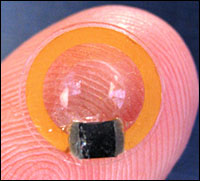
Eye Implant Monitors Pressure
DUISBURG, Germany, Sept. 5, 2007 -- An artificial lens with an integrated sensor is being developed as a permanent implant that could provide better long-term monitoring of high pressure in the eye, blood vessels, bladder or brain.
If the pressure in the eye is too high, nerve fibers die, resulting in visual field loss or blindness. Since increased intraocular pressure, also known as glaucoma, is not usually painful, the condition is often diagnosed too late. Also, these patients often tend to develop cataracts when they get older, which permanently cloud the lenses of their eyes.

On the edge of the artificial lens developed at the Fraunhofer Institute for Microelectric Circuits and Systems is a 2.5 x 2.6 mm sensor that measures intraocular pressure. (Image courtesy Fraunhofer IMS)
In such cases, surgeons remove the natural lens and replace it with an artificial one. To avoid further loss of nerve fibers, the intraocular pressure is then regulated as accurately as possible with the help of medication.
Unfortunately, the pressure continues to vary despite medication, obligating the patient to have it constantly monitored by doctors and the medication dosage adjusted accordingly.
Researchers at the Fraunhofer Institute for Microelectric Circuits and Systems (IMS) in Duisburg are hoping a sensor they are developing will eliminate the need for these patients to make constant visits to the doctor's office.
“We integrate the 2.5 by 2.6 millimeter sensor in the artificial lens,” said Thomas van den Boom, group manager for biohybrid systems at the IMS. “This doesn’t impair the patient’s vision.”
The top and bottom of the sensor are formed by electrodes; the top electrode is flexible, in contrast to its rigid counterpart on the bottom. When the intraocular pressure increases, the top electrode is pushed in, reducing the distance between the top and bottom of the sensor and increasing the capacitance.
Using a tiny antenna, the implant then sends the pressure data to a reader that is fitted into the frame of a pair of glasses. The patient can view the results on an auxiliary device and determine whether the pressure has reached a critical level.
An antenna in the glasses frame supplies the sensor with the required energy via an electromagnetic field. “The power consumption of the sensor must be kept to an absolute minimum,” van den Boom said. “All unused components are put in a kind of standby mode and only activated when needed.”
The permanent eye implant is currently undergoing clinical trials and could become widely available in two or three years, he said. The researchers are also investigating using the sensor in places other than the eye: When implanted in blood vessels in the thigh or the upper arm, it can also help patients with chronic hypertension, or high blood pressure.
“Conventional devices for measuring blood pressure at home are not suitable for determining the correct medication dosage,” said van den Boom.
The sensor is also expected to benefit patients suffering from increased intracranial pressure or those with incontinence problems.
For more information, visit: www.fraunhofer.de/fhg/EN/
Published: September 2007